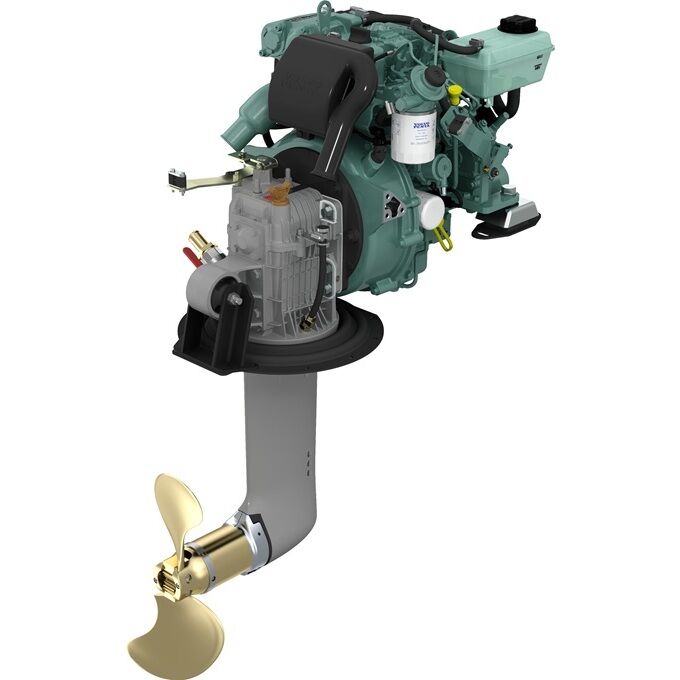Volvo Penta or Mercruiser Stern Drive Petrol Engines, Which One Should I Choose
For most of us, boating is all about R and R. Some of us go boating to land the big one, for others it’s about the best slalom ski manoeuver they can pull off, or it could be just a casual cruise enjoying dolphins or other sea creatures that us humans find so interesting. There are many important factors that make your trip safe and enjoyable, but a major factor has to be the reliability, safety and performance of the engine.
If we are talking petrol sterndrive engines, these days our choice is limited to Volvo Penta or Mercruiser. Both brands offer similar products with similar power options in the pleasure market range.
From a price point perspective, they are similar if you are choosing like for like products. The entry level product for both brands is the 200 HP single prop V6 with mechanical controls. The top options are around the 450 HP mark with electric controls. Mercruiser do offer some exotic racing products but as this is a comparison we will stick to the Leisure product that most of us will encounter.
Marine Engines And Reliability
If we are being realistic, both Volvo Penta and Mercruiser make good quality reliable products. Let’s face it, they have both been building stern drive petrol engines for over 50 Years. Volvo Penta have been building stern drive engines a little longer, though, with their first model launching in 1968. The AQ 80 S was a game changer. Up to this point the marine engine market had been limited to heavy inboards or very primitive 2 stroke outboards. Volvo Penta were the inventors of the Stern drive marine engine; Volvo Penta call it the Aquamatic. To the team at Aqua Power Marine reliability is our primary concern. A key factor relating to reliability is maintenance. Marine engines require maintenance regularly irrespective of hours used. Water pump impellers, drive bellows, filters and fluids all need changing even if your boat has only been used a small amount during the previous boating season.
What Are The Differences
Up until 2015 both Volvo Penta and Mercruiser shared a similar engine. The base engine was made by GM and shared automotive technology which had long been superseded due to poor emission standards and fuel efficiency. Port fuel injection, fixed camshaft timing, cast iron block and raw water cooling was the standard spec. In 2015 GM stopped producing the old iron engine and moved to a new all aluminium high pressure direct injection engine. This engine made massive torque and made power all the way up to 6,000 RPM. It was also 15 % more fuel efficient than the old engine. Volvo Penta adopted this engine as their new base engine. Mercruiser on the other hand decided to start manufacturing their own version of the iron GM engine increasing its capacity from 4.3 litres to 4.5 litres (5.7 to 6.2 for the V8 version).
What Does This Mean To Me
Variable cam shaft timing gives a broad spread of torque. This means great hole shot performance. When you hit the throttle the boat will accelerate quickly onto the plane and keep accelerating up to the maximum RPM. Volvo Penta product bulletins have torque curves showing this. We have been unable to find a torque curve for a Mercruiser.
High Pressure Direct Injection (HPDI) injects the fuel directly into the cylinder. This gives a cleaner exhaust and up to 15 % fuel saving over a port fuel injection system (PFI), remember Volvo HPDI, Mercruiser PFI.
The aluminium engine block reduces the weight of the engine by around 10%, this is despite our engine range being heat exchanger cooled as standard. This is an optional extra with Mercruiser.
In Summary
The Volvo Penta petrol engines are lighter than the comparable Mercruiser engine.
The Volvo Penta petrol engines have lower emissions than the comparable Mercruiser engine.
The Volvo Penta Petrol engines use less fuel than the comparable Mercruiser engine.
The Volvo Penta engine has freshwater cooling as standard.
Control Systems
Both Volvo Penta and Mercrusier offer electric controls, electric steering, and joystick systems. Having said this, Volvo Penta were the first to market with all three. Volvo Penta launched their first engine with electric controls in 1997 and their first electric steering system in 2004, adding joystick 12 months later. Volvo Penta also offer a range of Multi-Function Displays (MFDs) ranging from 7 inch to 28 inches with integrated autopilot, dynamic positioning, and assisted docking having been launched recently.
Learn More
If you are looking for a great deal on a Volvo Penta petrol engine visit us at the Melbourne boat show at stand 46 where we have one on display and talk to our experienced team.
If you’d like to learn more about Volvo Penta engines, find a dealer near you, or get in touch with us.



